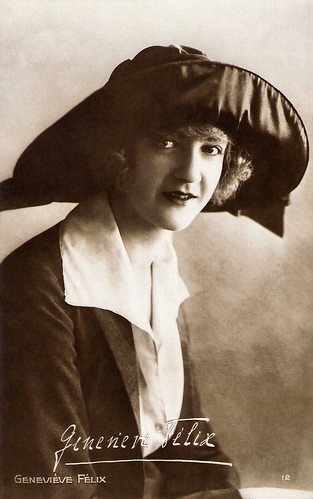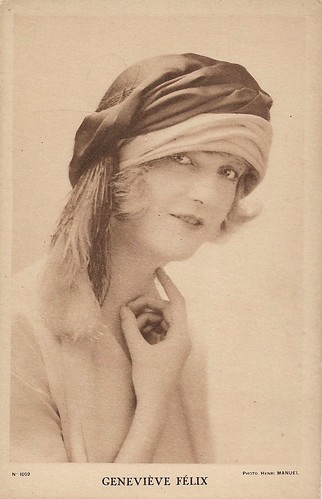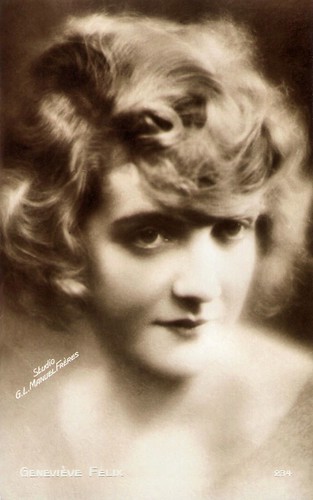Geneviève Félix (1901-?) was a French actress who had a brief but successful career in the silent cinema. After being a regular actress of Georges Champavert and Jean Kemm, she starred in the Victor Hugo adaptation La dame de Monsoreau (1925).

French postcard by Cinémagazine-Edition, no. 12.

French postcard, probably by Editions Filma, no. 1002. Photo: Henri Manuel.

French postcard by Editions Filma, no. 100. Photo: (Ruben) Sobol.
Geneviève Félix was born in Paris in 1901. In her teens, she was crowned Muse de Montmartre, a kind of beauty queen contest linked to French nationalism and republicanism. This probably gave her an introduction to the cinema.
In 1917 she debuted in the film Le ballon rouge/The Red Balloon, in which she played with Charles Lamy. She also appeared in a short production by the Eclipse company, La phalène bleue/The blue phalène (Georges Champavert, 1917).
Georges Champavert became her regular director in the late 1910s and their films include L’oeil de Saint-Yves/Saint Yves's eye (1919), Les deux jarretières/Both garters (1919), and Le passé renait/The Past Returns (1919). She also appeared in La chimère/The Fancy (Lucien Lehmann, 1919) with Edmond Van Daële, and L’engrenage/The Gearing (Louis Feuillade, 1919) with René Cresté.
In the early 1920s, Félix became the favourite actress of director Jean Kemm, who directed her in Miss Rovel (1920), Micheline (1921), La ferme du choquart/The Farm of Voquart (1921), Hantise/Obsession (1922), and L’absolution/The forgiveness (1922) with Pierre Blanchard. In 1923 Félix had become such a celebrated star that she was hired to endorse Crème Simon, a French heritage skincare brand founded by Joseph Simon in 1860.
In the mid-1920s, Félix played in various films by Georges Monca and Maurice Kéroul, such as L’ironie du sort/The Irony of Fate (Georges Monca, 1924), the Austrian film Die Geliebte des Mörders/The Lover of the Murderer (Maurice Kéroul, Max Reichmann, 1923), the crime film La double existence de Lord Samsey/The double existence of Lord Samsey (Maurice Kéroul, Georges Monca, 1924) in which Félix played the Lord in travesty, Altemer le cynique/Altemer, the Cynic (Georges Monca, 1924), Autour d’un berceau/Around a Cradle (Maurice Kéroul, Georges Monca, 1924), and a remake of Louis Feuillade’s L’engrenage/The Gearing (1925), this time directed by Kéroul and Reichmann.

French postcard by Cinémagazine, no. 97.

French postcard by A.N., Paris. In the series Les Vedettes de Cinéma, no. 42.
In 1924 Geneviève Félix played in the four-part crime serial La porteuse de pain/The Bread Peddler (René Le Somptier, 1924), starring Suzanne Desprès as Jeanne. Félix played Jeanne's daughter Lucie, who has been innocently imprisoned for murder, evaded and has become a bread peddler. Lucien (Jacques Guilhène), son of the victim, loves Lucie, ignoring her identity, while Mary, the daughter of the real murderer (Germaine Rouer), has set her eyes on Lucien.
Obviously, director Le Somptier liked Félix, because she got the lead in his subsequent film, the prestigious production La dame de Monsoreau/The Lady of Monsoreau (René Le Somptier, 1925), adapted from Victor Hugo’s novel. Félix plays Diane de Meridor, who is married but has an affair with Louis de Bussy. The story is set against the background of the religious and political factions in France by King Henry III. Félix’s co-stars in the film were Rolla Norman (Bussy) and Gina Manès (Mme de Saint-Luc).
Félix’ last silent film was Grand-mère/Grandmother (Albert-Francis Bertoni, 1925), starring Sylvio de Pedrelli and child star Régine Dumien. After that Félix was not seen in the cinema for years.
In 1932 she returned with the short sound film Arrêtez-moi/Stop Me! (Christian Matras, Charles-Félix Tavano, 1932), and she had a small part as the mother superior in another Dumas adaptation: Les trois mousquetaires/The Three Musketeers (Henri Diamant-Berger, 1933), which had Aimé Simon-Girard as D’Artagnan and Blanche Montel as Constance.
Here our bio stops. We could not find any information on the internet about Geneviève Félix’s whereabouts after the early 1930s, nor the date or place of her death. If you've more information, please let us know.

French postcard by Cinémagazine-Edition, Paris, no. 234. Poto: Studio G.L. Manuel Frères.

French postcard by Editions La Fayette in the Nos artistes dans leur loge series, no. 107. Photo Comoedia.
Sources: Jean-Pascal Constantin (Les Gens du Cinéma - French), Wikipedia (French and English) and IMDb.
This post was last updated on 6 March 2024.

French postcard by Cinémagazine-Edition, no. 12.

French postcard, probably by Editions Filma, no. 1002. Photo: Henri Manuel.

French postcard by Editions Filma, no. 100. Photo: (Ruben) Sobol.
Muse of Montmartre
Geneviève Félix was born in Paris in 1901. In her teens, she was crowned Muse de Montmartre, a kind of beauty queen contest linked to French nationalism and republicanism. This probably gave her an introduction to the cinema.
In 1917 she debuted in the film Le ballon rouge/The Red Balloon, in which she played with Charles Lamy. She also appeared in a short production by the Eclipse company, La phalène bleue/The blue phalène (Georges Champavert, 1917).
Georges Champavert became her regular director in the late 1910s and their films include L’oeil de Saint-Yves/Saint Yves's eye (1919), Les deux jarretières/Both garters (1919), and Le passé renait/The Past Returns (1919). She also appeared in La chimère/The Fancy (Lucien Lehmann, 1919) with Edmond Van Daële, and L’engrenage/The Gearing (Louis Feuillade, 1919) with René Cresté.
In the early 1920s, Félix became the favourite actress of director Jean Kemm, who directed her in Miss Rovel (1920), Micheline (1921), La ferme du choquart/The Farm of Voquart (1921), Hantise/Obsession (1922), and L’absolution/The forgiveness (1922) with Pierre Blanchard. In 1923 Félix had become such a celebrated star that she was hired to endorse Crème Simon, a French heritage skincare brand founded by Joseph Simon in 1860.
In the mid-1920s, Félix played in various films by Georges Monca and Maurice Kéroul, such as L’ironie du sort/The Irony of Fate (Georges Monca, 1924), the Austrian film Die Geliebte des Mörders/The Lover of the Murderer (Maurice Kéroul, Max Reichmann, 1923), the crime film La double existence de Lord Samsey/The double existence of Lord Samsey (Maurice Kéroul, Georges Monca, 1924) in which Félix played the Lord in travesty, Altemer le cynique/Altemer, the Cynic (Georges Monca, 1924), Autour d’un berceau/Around a Cradle (Maurice Kéroul, Georges Monca, 1924), and a remake of Louis Feuillade’s L’engrenage/The Gearing (1925), this time directed by Kéroul and Reichmann.

French postcard by Cinémagazine, no. 97.
French postcard by A.N., Paris. In the series Les Vedettes de Cinéma, no. 42.
Innocently imprisoned for murder
In 1924 Geneviève Félix played in the four-part crime serial La porteuse de pain/The Bread Peddler (René Le Somptier, 1924), starring Suzanne Desprès as Jeanne. Félix played Jeanne's daughter Lucie, who has been innocently imprisoned for murder, evaded and has become a bread peddler. Lucien (Jacques Guilhène), son of the victim, loves Lucie, ignoring her identity, while Mary, the daughter of the real murderer (Germaine Rouer), has set her eyes on Lucien.
Obviously, director Le Somptier liked Félix, because she got the lead in his subsequent film, the prestigious production La dame de Monsoreau/The Lady of Monsoreau (René Le Somptier, 1925), adapted from Victor Hugo’s novel. Félix plays Diane de Meridor, who is married but has an affair with Louis de Bussy. The story is set against the background of the religious and political factions in France by King Henry III. Félix’s co-stars in the film were Rolla Norman (Bussy) and Gina Manès (Mme de Saint-Luc).
Félix’ last silent film was Grand-mère/Grandmother (Albert-Francis Bertoni, 1925), starring Sylvio de Pedrelli and child star Régine Dumien. After that Félix was not seen in the cinema for years.
In 1932 she returned with the short sound film Arrêtez-moi/Stop Me! (Christian Matras, Charles-Félix Tavano, 1932), and she had a small part as the mother superior in another Dumas adaptation: Les trois mousquetaires/The Three Musketeers (Henri Diamant-Berger, 1933), which had Aimé Simon-Girard as D’Artagnan and Blanche Montel as Constance.
Here our bio stops. We could not find any information on the internet about Geneviève Félix’s whereabouts after the early 1930s, nor the date or place of her death. If you've more information, please let us know.

French postcard by Cinémagazine-Edition, Paris, no. 234. Poto: Studio G.L. Manuel Frères.

French postcard by Editions La Fayette in the Nos artistes dans leur loge series, no. 107. Photo Comoedia.
Sources: Jean-Pascal Constantin (Les Gens du Cinéma - French), Wikipedia (French and English) and IMDb.
This post was last updated on 6 March 2024.
No comments:
Post a Comment